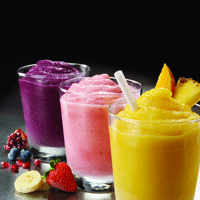The race to claim the title as the top-performing foodservice segment in Canada isn’t even close, with word that quick-serve restaurants (QSRs) brought in $21.6 billion in 2011, accounting for 34.6 per cent of the country’s foodservice market. Further, the top six QSR chains in Canada performed well in 2011, posting year-over-year sales increases. The segment is clearly doing well, and operators are starting to understand that an ongoing commitment to menu diversification, consumer responsiveness and staying on top of trends is necessary to ensure continued success.
Coffee Competition Heats Up
A coffee war is waging in Canada, and Tim Hortons and McDonald’s — the number-1 and number-2 chains in the country by sales and units, respectively — are on the front line. Both chains made headlines last year with their coffee programs. Tim Hortons launched a line of freshly prepared espresso drinks made with arabica beans. As part of the launch, new equipment was installed in stores so drinks could be prepared with espresso-roasted coffee beans and steamed or frothed milk, a step up from the previous powder-based drinks. Meanwhile, McDonald’s took its McCafé program north, introducing Canadians to its line of premium espresso-based beverages, also made with arabica beans. The result? The top two Canadian chains are battling it out with similar beverage programs, marked by comparable price points and menu items, making the competition to capture consumers’ coffee dollars fiercer than ever.
Breakfast Menus Evolve
Enhanced coffee programs are playing an integral role in another major trend: the expansion of breakfast menus. More quick-serve operators are broadening core breakfast offerings in the hopes of driving morning traffic. Gone are the days when breakfast at a QSR meant egg-and-meat sandwiches, hash browns and regular black coffee. Breakfast menus now showcase unexpected items, from lunch-centric sandwiches and specialty bagels to oatmeal and smoothies. Last December, Subway Restaurants, with sales of $1.5 billion in 2011, added the B.M.T. Melt, a new breakfast sandwich, which combines pepperoni, salami and ham with a choice of egg. In January, Calgary’s Good Earth Coffeehouse and Bakery rolled out customizable oatmeal. A month later, Tim Hortons introduced three new specialty bagels. A month after that, the Canadian chain entered the smoothie market, launching a Peach Mango Smoothie at participating locations; McDonald’s countered by introducing a line of McCafé Real Fruit smoothies at select locations.
The Fourth Daypart
Specialty coffee drinks and smoothies are popular anytime snacks, making them part of another trend contributing to the shakeup within traditional dayparts: the uptick in snacking. Technomic’s 2012 “Canadian Snacking Consumer Trend Report” found consumers are snacking much more frequently now than they were two years ago, with more than half of those polled (56 per cent) saying they snack at least twice a day, compared to just a quarter (25 per cent) of respondents surveyed in 2010. Not only are consumers snacking more frequently, they’re also increasingly nibbling throughout the day and well into the night. Operators are starting to recognize around-the-clock snacking means flexibility — in terms of expanded hours of service and continued menu diversification — may be required to satisfy guests. Late last year, for example, Tim Hortons extended its breakfast hours until noon, seven days a week.
The Segment Situation
QSRs aren’t the basic fuelling stations they once were. Now consumers are expecting the best value at the lowest price. Find out the trends driving this area of the market.
“Better Burgers” Drive Sales, Bolster the Burger Category
The limited-service burger category has experienced a boon in recent years, growing sales 4.4 per cent between 2010 and 2011. “Better burgers,” marked by premium ingredients and a slightly higher cost, have a lot to do with that sales uptick. Better burgers is one of the biggest buzz terms in the QSR burger market, but it’s important to emphasize that dollar/value-menu burgers will always have a place on QSR menus. But, taking a cue from casual-dining restaurants and fast-casuals, the leading QSR burger brands have introduced better burgers, many of which incorporate Angus beef and “gourmet” toppings and sauces. In February, Burger King Canada, which posted 2011 sales of $347 million, brought back the Mushroom and Swiss Steakhouse XT for a limited time; it features an Angus beef patty. And, late last year, Harvey’s debuted a Great Canadian Spicy Onion Bacon Burger, part of the chain’s premium line of Great Canadian Burgers, featuring flame-grilled beef patties.
Pizza Category Takes a Hit; Operators Diversify Menus
Limited-service restaurant (LSR) pizza chains did not fare well last year. Technomic reports that between 2010 and 2011, LSR pizza-chain sales retracted 3.3 per cent to $1.5 billion. The top two players, Pizza Pizza and Pizza Hut, posted sales declines (-10.2 per cent and -2.2 per cent, respectively). Domino’s Pizza, with sales of $230 million, up from the previous year’s $173 million, had a strong year; however, the number-3 pizza chain’s sales increase wasn’t enough to raise the segment’s sales. Amidst this tough operating environment, some pizza brands have focused their efforts on diversifying the menu beyond pizza, specifically by introducing new chicken offerings. Domino’s Pizza Canada introduced boneless chicken.
The chicken offering features white breast meat lightly breaded with herbs. Western Canada’s Pizza 73, whose sales are included in the Pizza Pizza totals, followed suit earlier this year, rolling out Buffalo chicken wings. Other brands have made a move toward better-for-you offerings. In November, Pizza Pizza announced it had earned the Heart & Stroke Foundation’s Health Check on five menu items.
Quick-Serve Prices, Fast-Casual Ambiance
QSRs are increasingly serving better coffee, better burgers and better-for-you pizza, which begs the question, “Should better food be served in a better setting?” Some operators are responding with a resounding “yes,” taking steps to upgrade the decor and ambiance of their restaurants to make them more in line with fast-casuals. In late 2011, Wendy’s Canada, which posted sales of $641 million, down from last year’s $650 million, opened its first new-concept store. The unit in Etobicoke, Ont., features a design that offers more open space, a brighter dining room with larger windows and a variety of seating, ranging from booths to high-top tables to comfortable lounge chairs surrounding a fireplace. For its part, Tim Hortons announced plans to introduce a new upscale design marked by a new layout, armchairs, soft lighting, Wi-Fi and open kitchens.
Menu trends
QSR menus are rapidly expanding with the introduction of premium coffee programs, more diverse breakfast offerings, upscale burgers and more chicken at pizza chains, but, beyond that, specific menu trends are picking up momentum.
Breadless Sandwiches
Menus are starting to reflect a shift toward non-traditional sandwich breads. Basic white and wheat bread are taking a back seat to everything from pita and tortillas to biscuits. Technomic’s exclusive menu-tracking resource, “Menu-Monitor,” reveals pitas were the top sandwich bread on limited-service restaurant menus in late 2011. Kingston, Ont.’s Pita Pit, which ranks 38th on the Top 100 with sales of $130 million, up from $117 million, for example, has built its brand around Lebanese-style pita sandwiches. Tortilla-based wraps and bagels are an offshoot of the non-traditional sandwich trend. Some chains are forgoing bread altogether, popularizing breadless sandwiches. In mid-March, KFC Canada brought back the Double-Down sandwich and introduced the new limited-time Zinger Double Down sandwich, which features two chicken breasts in lieu of bread.
Ethnic Cuisines Spice Up Segment
A look at the leading Canadian chains shows ethnic cuisine has a ways to go before it fully penetrates the market. Among F&H’s Top 100 list, there are brands that specialize in Greek, Italian, Mexican and Thai, but there’s room to grow the market. Rather, new ethnic flavours come mostly in the form of new or limited-time rollouts at non-ethnic brands. For instance, Vancouver’s White Spot added a Santa Fe Breakfast Burrito. The good news is consumers are interested in ethnic fare. In surveying Canadian consumers for its 2011 “Flavour Consumer Trend Report,” Technomic found nearly one in three consumers (32 per cent) say they are more interested in ethnic flavours and cuisines than they were a year ago. Food trucks represent one area where ethnic fare is gaining a solid footing, supplying the demand for authentic global flavours at lunch. Many Canadian food trucks feature globally focused menus. For example, Ontario’s El Gastronomo Vagabundo offers a globe-spanning menu of gourmet tacos, tapas and Southeast Asian dishes and Calgary’s Naaco Truck serves Indian faves such as butter chicken and beef vindaloo.
Local, Artisan Food Movement Finds Following
In its Canadian “Lunch Consumer Trend Report,” Technomic found that about a third of consumers say natural, sustainable and local attributes are important to them when choosing lunch items. As more menu developers recognize these issues are increasingly important to customers, more local and artisanal fare will appear on menus — although the trend will likely take longer to trickle down to QSRs than other segments.
Increasing Costs
Some menu trends are tied to cost. Purchasing locally sourced ingredients costs operators more than buying ingredients from a central distribution centre. As such, operators who want to incorporate local and possibly organic offerings are confronted with higher food costs — and they may have to pass those higher costs to customers. Starbucks Canada raised prices for coffee and specialty beverages in response to rising coffee and commodity prices. But, commodity costs are rising across the board, and the trend is not specific to food with a premium positioning (namely local, organic and sustainable).
The road ahead
The QSR market is rife with change. As the first half of 2012 draws to a close and operators start looking for ways to finish the year with strong sales, expect these trends to proliferate, with beverages and breakfast making a noticeable impact. Soft lunch sales will mean breakfast will be served beyond traditional morning hours, and snacking items, especially beverages such as coffee, tea and smoothies, will take on greater significance. Smart operators will innovate with menus and expand offerings and hours, while upgrading decor to stay a step ahead of the competition.
Keep Reading





















